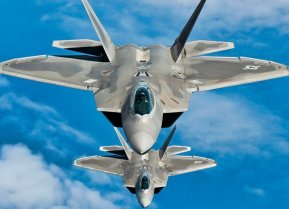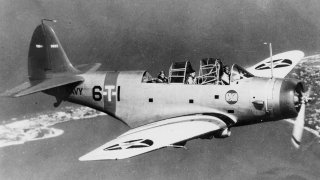Douglas Devastator: The Navy Bomber That Helped Win World War II
The World War II warplane Douglas Devastator excelled during the Battle of the Coral Sea, which took place from April 29 to May 8, 1942
Douglas TBD Devastator Early History and Specifications: The TBD Devastator made her maiden flight on April 15, 1935, and officially entered into operational service with the U.S. Navy on Aug. 3, 1937.
At the time of her acceptance by the Navy, the Devastator was the most advanced naval aircraft in the world. Tragically, this lofty status didn’t last long.
Specifications included a three-man crew (pilot, navigator/torpedo officer, and radioman/gunner), a fuselage length of 35 feet, a wingspan of 50 feet, a height of 15 feet 1 inch, an empty weight of 5,600 pounds, and a maximum takeoff weight of 9,289 lbs. Max airspeed was 206 miles per hour, with a cruise speed of 128 mph. Armament consisted of a single MK 13 torpedo, along with a forward-firing .30 caliber machine gun and a .30 caliber machine gun in the rear cockpit.
Battle of the Coral Sea: the Devastator’s “One Brief Shining Moment”
“Every dog has his day,” as the saying goes, and this was true even of the star-crossed TBD. The Devastator excelled during the Battle of the Coral Sea, which took place from April 29 to May 8, 1942, and, as noted by the Naval History and Heritage Command info page, “was the first time since the Japanese attack on Pearl Harbor that the enemy’s seemingly relentless advance into the Pacific was checked.”
During this battle, the TBDs, in tandem with Douglas SBD Dauntless dive bombers, sank the Imperial Japanese Navy (IJN) light aircraft carrier Shōhō, marking the IJN’s first carrier loss of WWII. In the process, the Devastators lived up to their name by scoring at least seven torpedo hits. Along with thirteen 1,000-lb. bomb hits from the Dauntless, these killed the 11,443-ton vessel along with 834 of her crew, in turn prompting the famous radio message, “Dixon to carrier: Scratch one flattop!”
Battle of Midway: the Tragic Tale of VT-8
Alas, barely a month later, the Battle of Midway would show that the Devastator’s moment of glory was fleeting indeed. The same plane that had been state-of-the-art at her inception was now slow and lumbering, easy prey for IJN Mitsubishi Zero fighters and triple-A guns during the torpedo bombers’ ill-fated attack on the Japanese carriers. The TBD crews scored nary a single hit on any enemy warships while losing 35 out of 41 of their number. Especially grievous was the example of the USS Hornet’s Torpedo Squadron Eight (VT-8), which lost every single one of its Devastators. Ensign George Henry Gay Jr. was the sole survivor of VT-8.
But the TBD crews’ sacrifices were not in vain. They kept Japanese sailors and aviators distracted long enough for Douglas Dauntless crews to avenge their shipmates by swooping in and lay waste to the IJN carriers Akagi, Kaga, and Sōryū — Hiryū would be sunk later on in the engagement — thus turning the tide of the Pacific war.
A harrowingly detailed recounting of the Devastator crews’ ordeal is provided by the late historian Gordon W. Prange in his bestselling 1982 book Miracle at Midway, co-authored by Donlad M. Goldstein and Katherine V. Dillon.
The TBD would soon be replaced by the Grumman TBF Avenger.
Where Are They Now?
To compound the tragic tale of the TBDs at Midway, there are no bona fide surviving airframes out of the 130 total built. The closest thing that my fellow history museum enthusiasts will find is a near full-sized replica that was originally built for the 2019 motion picture Midway and later generously donated by Lionsgate to the USS Midway Museum in San Diego, California.
That said, there is a proposed expedition to recover the remains of seven Devastators from the wreckage of the aircraft carrier USS Lexington, which currently lies in her watery grave roughly two miles below the surface of the Coral Sea, more than 500 miles off the eastern coast of Australia.
Plastic model-building hobbyists have a few options to choose from, such as a Monogram 1:48 scale and a Trumpeter 1:200 scale kit.
About the Author
Christian D. Orr is a former U.S. Air Force Security Forces officer, Federal law enforcement officer, and private military contractor (with assignments worked in Iraq, the United Arab Emirates, Kosovo, Japan, Germany, and the Pentagon). Chris holds a B.A. in International Relations from the University of Southern California (USC) and an M.A. in Intelligence Studies (concentration in Terrorism Studies) from American Military University (AMU). He has also been published in The Daily Torch and The Journal of Intelligence and Cyber Security. Last but not least, he is a Companion of the Order of the Naval Order of the United States (NOUS).
Image Credit: Creative Commons.


